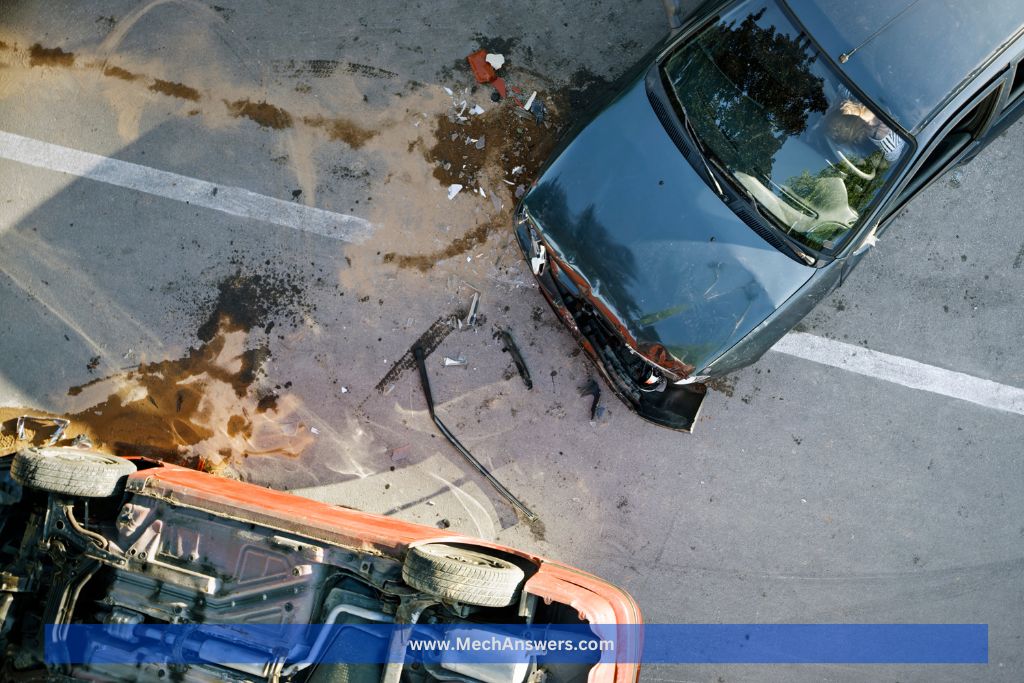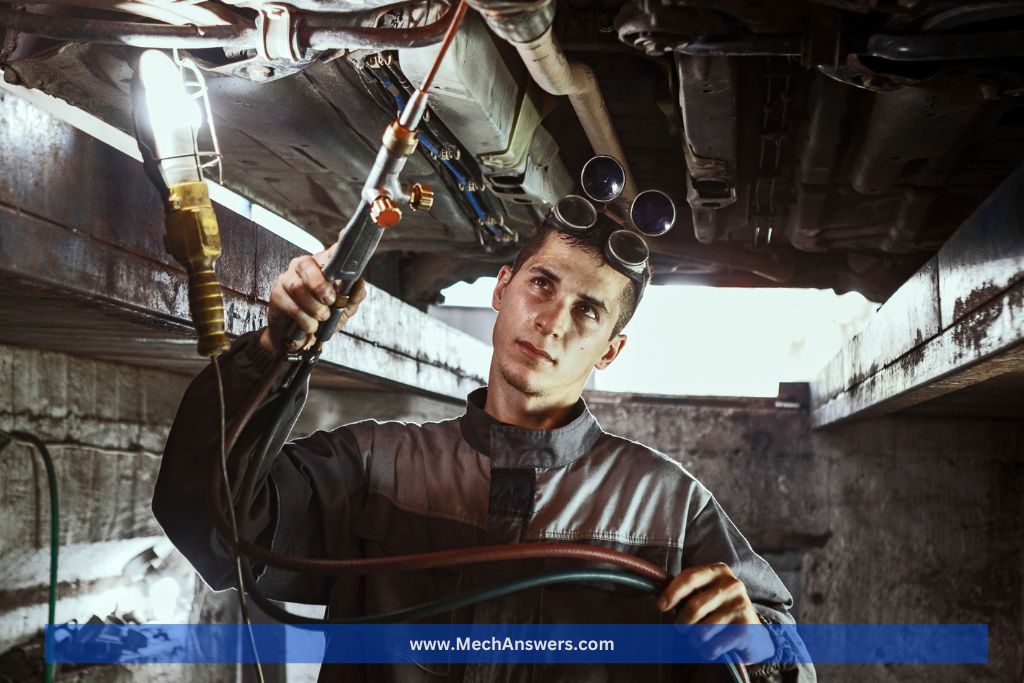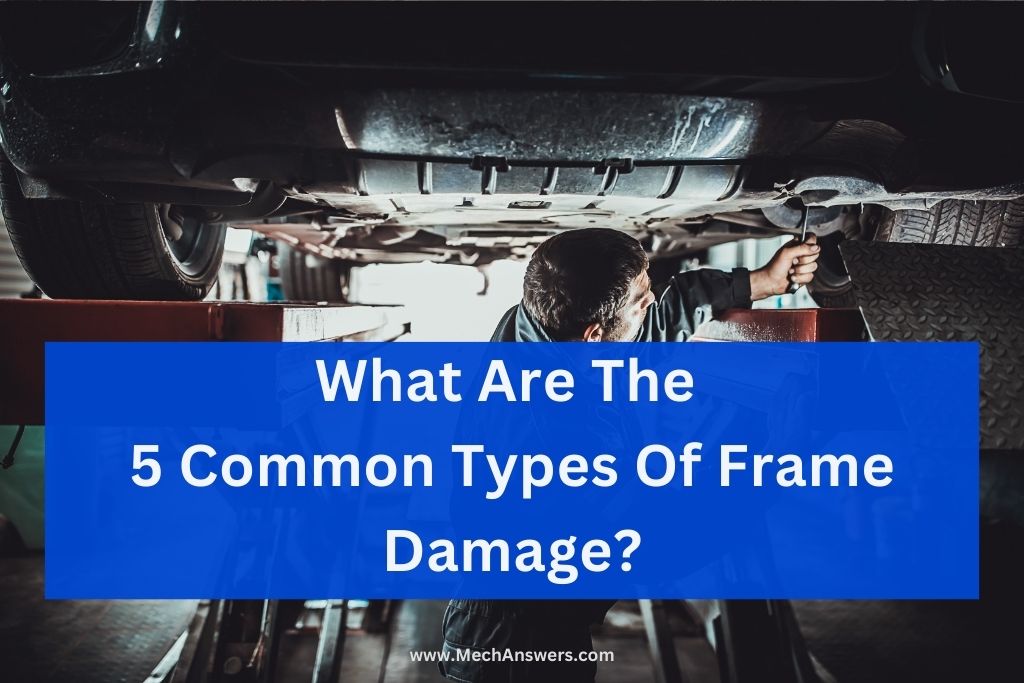Have you ever found yourself in a predicament, wondering “What Are The 5 Common Types Of Frame Damage?” Don’t stress any longer – you’ve found the right article.
So, what can you expect from “What Are The 5 Common Types Of Frame Damage?” In this piece, we delve into the details, defining and explaining the five prevalent types of frame damage that commonly plague vehicles.
We’ll also discuss the causes and potential effects of each type to give you a comprehensive understanding. Gaining knowledge about frame damage will enable you to spot issues early, potentially saving you costly repairs and maintaining the safety of your vehicle.
Table of Contents
Type 1: Collision Damage
Introduction to collision damage
Definition:
Collision damage refers to the physical harm caused to a vehicle’s frame as a result of an impact on another object, such as another vehicle, a stationary object, or a pedestrian.
Causes:
Common causes include high-speed impacts, distracted driving, adverse weather conditions, and reckless driving behaviors.
Examples:
Collision damage can range from minor dents and scratches to severe structural deformations that compromise the vehicle’s safety and performance.
Types of collision damage
1. Front-end collisions
Common effects on the frame:
Front-end collisions often result in damage to the front bumper, grille, headlights, hood, and front suspension components. More severe impacts can cause the frame to buckle or crumple, leading to misalignment and other structural issues.
Potential repair options:
Depending on the extent of the damage, repairs may involve replacing damaged components, straightening the frame, or conducting a full frame replacement. In some cases, the vehicle may be deemed a total loss if repairs are not cost-effective or feasible.
2. Rear-end collisions
Common effects on the frame:
Rear-end collisions can cause damage to the rear bumper, taillights, trunk, and rear suspension components. In more severe cases, the frame may be bent or twisted, resulting in alignment issues and other structural problems.
Potential repair options:
Similar to front-end collisions, repairs may involve replacing damaged components, straightening the frame, or conducting a full frame replacement. The vehicle’s repairability will depend on the extent of the damage and the cost-effectiveness of the repair.
3. Side-impact collisions
Common effects on the frame:
Side-impact collisions can result in damage to the doors, windows, side panels, and side-impact protection structures. Severe impacts can cause the frame to bend or twist, compromising the vehicle’s structural integrity.
Potential repair options:
Repairs may involve replacing damaged components, straightening the frame, or conducting a full frame replacement. In some cases, a side-impact collision may render the vehicle irreparable, particularly if the cost of repairs exceeds the vehicle’s value.
Repairability of collision damage
Factors affecting repairability:
The repairability of collision damage depends on several factors, including the extent and location of the damage, the age and value of the vehicle, and the availability of replacement parts. In some cases, frame damage may be too severe to repair safely or economically.
Consequences of not repairing collision damage:
Ignoring collision damage can lead to further deterioration of the vehicle’s frame, resulting in reduced performance, safety risks, and decreased resale value. Unrepaired frame damage can also make it more difficult to obtain insurance coverage or pass vehicle inspections.
Prevention and mitigation strategies
Safe driving practices:
To minimize the risk of collision damage, drivers should follow safe driving practices such as maintaining a safe following distance, obeying traffic laws, avoiding distractions, and being vigilant in adverse weather conditions.
Vehicle safety features:
Modern vehicles are equipped with a variety of safety features designed to help prevent or minimize collision damage.
These include airbags, crumple zones, anti-lock braking systems (ABS), electronic stability control (ESC), and advanced driver assistance systems (ADAS) like forward-collision warning and automatic emergency braking.
Ensuring that these safety features are in good working order can help protect both the vehicle and its occupants in the event of a collision.

Type 2: Rust and Corrosion Damage
Introduction to rust and corrosion damage
Definition:
Rust and corrosion damage refers to the chemical deterioration of a vehicle’s frame, primarily caused by the oxidation of metal components in the presence of moisture, oxygen, and other corrosive substances.
Causes:
The primary cause of rust and corrosion is the exposure of metal components to moisture, oxygen, and corrosive substances such as road salt, chemicals, and acidic substances.
Examples:
Rust and corrosion damage can manifest as surface rust, localized pitting, or widespread deterioration of the frame, leading to weakened structural integrity.
Effects of Rust and Corrosion on the Frame
Structural integrity:
Rust and corrosion can compromise the structural integrity of the frame, making it more susceptible to damage and increasing the risk of catastrophic failure under stress.
Aesthetic issues:
Rust and corrosion can cause unsightly blemishes on the vehicle’s exterior, leading to a decrease in the overall appearance and value of the car.
Safety concerns:
As rust and corrosion weaken the frame, they can increase the risk of accidents or injuries due to a reduced ability to withstand impact forces in the event of a collision.
Repairing rust and corrosion damage
Methods for removing rust and corrosion:
Rust and corrosion can be removed through various methods, including chemical treatments, abrasive methods (e.g., sanding or grinding), and media blasting (e.g., sandblasting or soda blasting). The appropriate method depends on the extent and location of the damage.
Restoring the frame:
After removing rust and corrosion, the frame may need to be repaired or reinforced to restore its structural integrity. This can involve welding new sections of metal, applying reinforcement patches, or replacing severely damaged components.
Preventative measures:
To prevent further rust and corrosion, protective measures such as applying rust-resistant coatings, using corrosion inhibitors, and sealing any exposed metal surfaces can be employed.
Prevention and maintenance tips
Regular inspection:
Conducting routine inspections of the vehicle’s frame and undercarriage can help identify early signs of rust and corrosion, allowing for timely intervention and repair.
Protective coatings:
Applying protective coatings, such as rust inhibitors, undercoating, or paint, can provide an additional barrier against moisture and other corrosive elements, prolonging the life of the frame.
Environmental considerations:
Reducing exposure to corrosive substances and environments can help minimize the risk of rust and corrosion.
This includes avoiding driving on salted roads during winter months, promptly washing the vehicle after exposure to corrosive substances, and storing the vehicle in a dry, well-ventilated area when not in use.

Type 3: Bent or Twisted Frames
Introduction to bent or twisted frames
Definition:
Bent or twisted frames refer to deformations in a vehicle’s frame caused by excessive force or stress, resulting in compromised structural integrity and alignment.
Causes:
Common causes include high-impact collisions, carrying excessive loads, off-road driving, and exposure to extreme conditions or forces.
Examples:
Bent or twisted frames can manifest as uneven gaps between body panels, misaligned wheels, or uneven tire wear, leading to reduced vehicle performance and safety.
Effects of Bent or twisted frames on vehicle performance
Alignment issues:
A bent or twisted frame can cause improper wheel alignment, leading to uneven tire wear, reduced fuel efficiency, and impaired handling.
Suspension problems:
Frame deformations can negatively impact the vehicle’s suspension system, resulting in reduced ride comfort, increased wear on suspension components, and compromised handling capabilities.
Tire wear:
Misaligned wheels due to a bent or twisted frame can cause uneven or accelerated tire wear, necessitating more frequent tire replacements and increasing the risk of tire failure.
Safety concerns:
A compromised frame can reduce the vehicle’s ability to withstand and absorb impact forces in the event of a collision, potentially increasing the risk of injury to occupants.
Repairing bent or twisted frames
Frame straightening techniques:
Repairing a bent or twisted frame typically involves using specialized equipment, such as hydraulic frame straighteners or frame jigs, to apply controlled force and heat to restore the frame to its original shape and alignment.
Limitations and potential complications:
Depending on the severity and location of the damage, some frame deformations may be beyond repair, requiring a complete frame replacement. Additionally, improper frame repair can lead to weakened structural integrity, affecting the vehicle’s safety and performance.
Prevention and detection
Regular inspections:
Conducting routine inspections of the vehicle’s frame and undercarriage can help identify signs of bending or twisting, allowing for timely intervention and repair.
Avoiding heavy loads and extreme conditions:
To minimize the risk of frame damage, drivers should avoid carrying excessive loads, engaging in extreme off-road driving, or exposing the vehicle to extreme forces and conditions.
Recognizing signs of a bent or twisted frame:
Early detection of a bent or twisted frame can be achieved by monitoring for symptoms such as uneven tire wear, irregular gaps between body panels, impaired handling, or a pulling sensation while driving.
If any of these signs are observed, a professional inspection should be conducted to assess and address the issue.
The 5 Types of Frame Damage with Bill Bacon >> Check out the video below:
Type 4: Stress Cracks
Introduction to stress cracks
Definition:
Stress cracks are small fractures or splits that form in a vehicle’s frame due to excessive stress, fatigue, or tension in the material.
Causes:
Common causes of stress cracks include prolonged exposure to extreme conditions, excessive loads, manufacturing defects, and repeated stress or strain on specific areas of the frame.
Examples:
Stress cracks can appear in areas of the frame that are subjected to repeated stress or strain, such as weld joints, suspension mounting points, or areas with inadequate reinforcement.
Effects of stress cracks on vehicle performance
Reduced structural integrity:
Stress cracks can weaken the frame’s overall strength and stability, compromising the vehicle’s structural integrity and performance.
Potential for further damage:
Untreated stress cracks can grow and expand over time, potentially leading to more severe damage or even catastrophic failure of the frame.
Safety concerns:
The presence of stress cracks can reduce the frame’s ability to absorb and distribute impact forces during a collision, increasing the risk of injury to occupants.
Repairing stress cracks
Welding and reinforcement techniques:
Repairing stress cracks typically involves welding the cracked area and reinforcing it with additional metal or patches to restore the frame’s strength and integrity. In some cases, specialized techniques such as stitch welding or the use of epoxy resins may be employed to address the issue.
Assessing repairability:
Depending on the severity, location, and extent of the stress cracks, some cases may be deemed beyond repair, necessitating a complete frame replacement. A professional inspection should be conducted to determine the most appropriate course of action.
Prevention and early detection
Routine inspections:
Regularly inspecting the vehicle’s frame and undercarriage can help identify stress cracks before they become severe, allowing for timely intervention and repair.
Avoiding extreme conditions:
To minimize the risk of stress cracks, drivers should avoid exposing their vehicles to extreme conditions, such as heavy loads, rough terrain, or excessive vibration.
Recognizing signs of stress cracks:
Early detection of stress cracks can be achieved by monitoring for symptoms such as unusual noises (e.g., creaking or popping sounds), visible cracks or fractures in the frame, or changes in the vehicle’s handling and performance.
If any of these signs are observed, a professional inspection should be conducted to assess and address the issue.
Related Articles:
Read more >> 15 Best Ways How To Check Car Chassis Damage Like A Pro!
Read more >> What Happens If A Frame Breaks While Driving? (Explained!)
Read more >> 12 Analytical Signs: How To Tell If A Frame Is Too Rusted

Type 5: Poor Repair or Modification
Introduction to poor repair or modification
Definition:
Poor repair or modification refers to substandard or improper work done on a vehicle’s frame, which can lead to compromised structural integrity, performance issues, and safety concerns.
Causes:
Common causes include inexperienced or unqualified technicians, inadequate tools or equipment, shortcuts taken during the repair process, or modifications that do not adhere to manufacturer guidelines or industry standards.
Examples:
Examples of poor repair or modification can include poorly welded frame components, improper frame straightening, or the use of substandard materials during the repair process.
Effects of poor repair or modification on vehicle performance
Compromised structural integrity:
Substandard repairs or modifications can weaken the frame, affecting the overall strength and stability of the vehicle.
Alignment and suspension issues:
Poor repair or modification can lead to alignment and suspension problems, resulting in uneven tire wear, reduced fuel efficiency, and impaired handling.
Safety concerns:
Improper repairs or modifications can compromise the vehicle’s ability to withstand and absorb impact forces during a collision, potentially increasing the risk of injury to occupants.
Repairing and addressing poor repair or modification
Assessing the extent of the damage:
A thorough inspection by a qualified professional is necessary to determine the extent of the damage caused by poor repair or modification.
Correcting improper repairs:
Depending on the findings of the inspection, corrective measures may be taken, such as re-welding frame components, realigning the frame, or replacing damaged parts.
Reversing or rectifying modifications:
In some cases, it may be necessary to reverse or rectify modifications that do not adhere to manufacturer guidelines or industry standards, restore the vehicle to its original specifications, or make improvements in line with best practices.
Evaluating repairability and potential complications:
In severe cases, the damage caused by poor repair or modification may be irreparable, necessitating a complete frame replacement or rendering the vehicle a total loss. A professional assessment will help determine the most appropriate course of action.
Prevention and best practices for repairs and modifications
Choosing reputable repair shops and technicians:
To minimize the risk of poor repair or modification, it is crucial to select reputable repair shops and technicians with a proven track record of quality work.
Ensuring proper certification and training:
Technicians should have the necessary certifications and training to perform frame repairs and modifications, ensuring that they possess the skills and expertise to carry out the work correctly.
Following manufacturer recommendations and guidelines:
Adhering to manufacturer recommendations and industry guidelines can help ensure that repairs and modifications are performed to the highest standards, preserving the vehicle’s structural integrity and performance.
Regular inspections and maintenance checks:
Conducting routine inspections and maintenance checks can help identify any issues resulting from poor repair or modification, allowing for timely intervention and corrective action.
Conclusion
Frame damage is a serious issue that can greatly impact the safety and functionality of a vehicle. Understanding the five common types of frame damage – buckling, twisting, rust, impact, and cracking – can help vehicle owners identify potential problems and seek timely repairs.
It’s important to note that frame damage is not always immediately visible, so it’s crucial to have a trained mechanic inspect the vehicle if there are any concerns. By addressing frame damage promptly, owners can ensure the safety and longevity of their vehicles.

